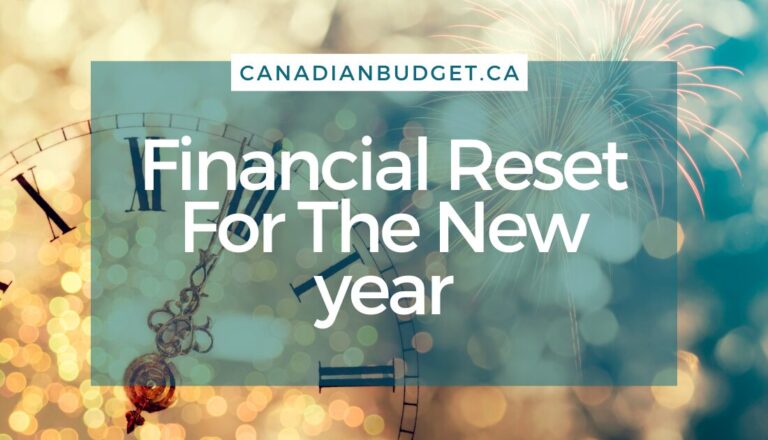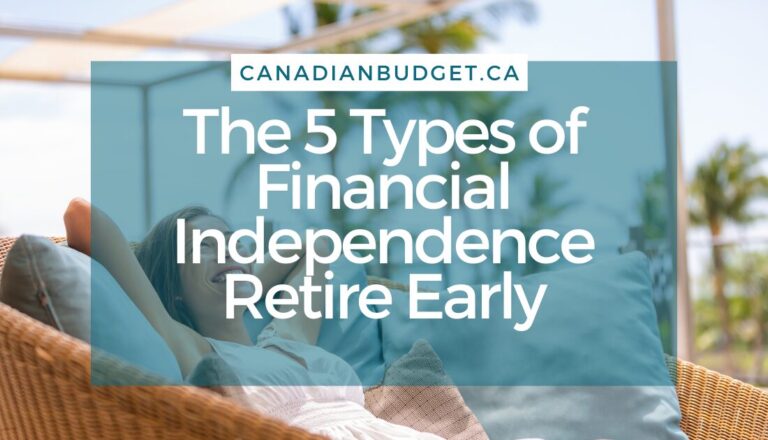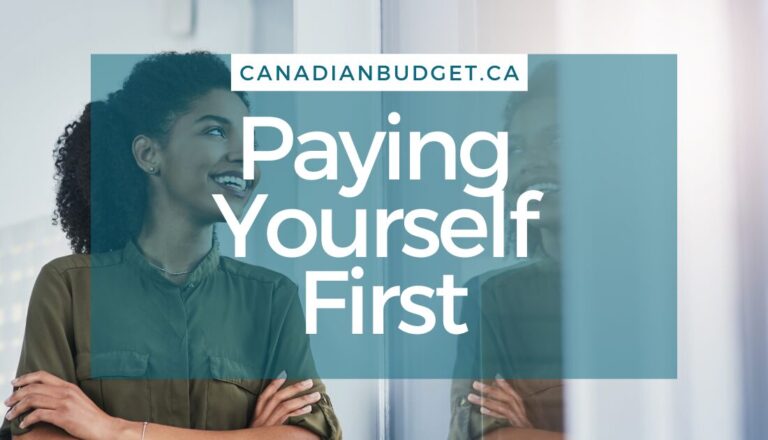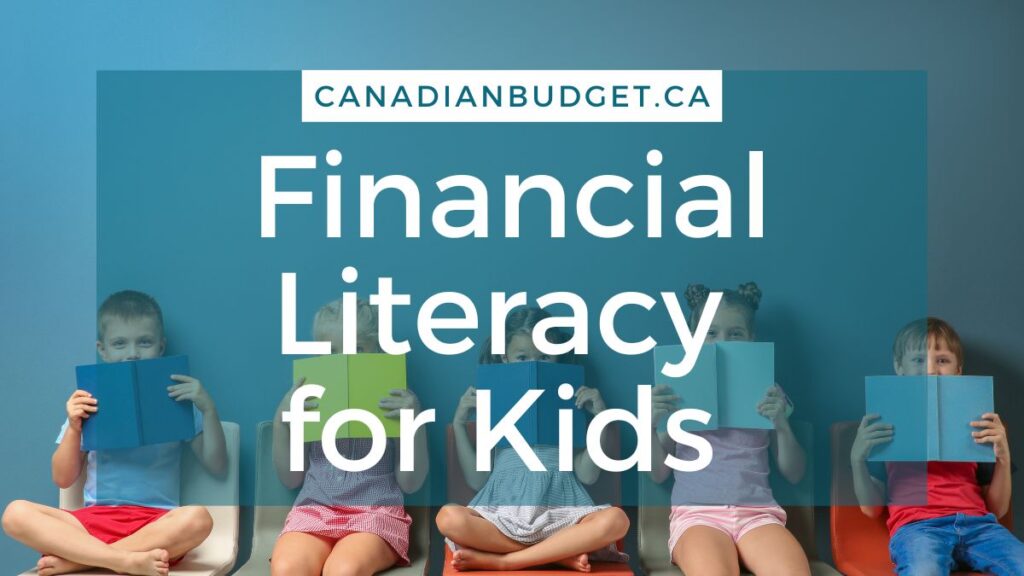Financial Literacy for Kids: Kid friendly resources to set your children up for success
Table of Contents
ToggleIn a world where financial literacy is becoming increasingly essential, teaching kids money concepts early in their lives is a powerful tool that can shape their financial futures. Just think about your financial situation today and how much better off you would have been if you had learned the basics of personal finance when you were young!
In this article, we will delve into why teaching financial literacy for kids from a young age is beneficial, focusing on mindset and good habits, and provide a list of Canadian kids’ books that do just that.
Evaluating Our Own Financial Literacy
Many adults I know would give anything to go back in time and, knowing what they know now about money and investing, have a chance to do it all again. So why not take that approach and give our kids the knowledge they need to succeed earlier in life, rather than letting them figure it all out on their own through trial and error?
Most Canadians learned their money habits by observing their parents, not through any formal learning. Money was one of those taboo subjects that parents didn’t want to have to talk to their kids about, so the only way to learn was through observation and making their own mistakes along the way.
These days, parents are more aware of the fact that teaching financial literacy for kids starting from an early age is vital so they can set their children up for financial success. Trying to start exposing children to age-appropriate resources about money can help them build the skills they need from a younger age.
When we think about the impact of financial literacy for kids, it’s crucial to focus on practical skills, nurturing a healthy money mindset and instilling good financial habits in children.
In Canada, where personal finance plays a significant role in our daily lives, empowering the next generation by teaching financial literacy for kids and fostering a positive mindset is more important than ever. Until very recently in Canada, no personal finance education was taught in schools. Hopefully, that trend will continue to reverse, and more personal finance content will be added to the curriculum across various grade levels in all provinces.
The Foundation of Financial Literacy for Kids
Financial literacy is like a house; it needs a solid foundation. By teaching children about money early in life, they build the groundwork to make sound financial decisions throughout their lifetime. A child who understands the basic concepts of earning, saving, spending, donating and investing will be better equipped to navigate the complex financial landscape they will face as adults.
Age-appropriate money concepts and lessons can be shared with your kids as they grow. Early education around money concepts helps build skills in financial literacy for kids, setting them on the path to financial success.
Shaping a Positive Money Mindset in Kids
A healthy money mindset is just as important as financial knowledge. Children who grow up with a positive attitude towards money are likelier to develop a healthy relationship with it. Teaching kids about money early allows us to instill the values of responsibility, accountability, and financial independence. By encouraging children to view money as a tool to achieve their goals rather than a source of stress, we can help them develop a positive money mindset that will serve them well throughout their lives.
Fostering Good Financial Literacy For Children
The habits we form as children often stay with us into adulthood. Teaching kids about money from an early age allows us to shape their financial behaviors and habits. By emphasizing the importance of saving, budgeting, and setting financial goals, we can help children develop good financial habits that will serve them well in the future. These habits include setting aside a portion of their allowance or earnings for savings, understanding the concept of delayed gratification, and making thoughtful spending decisions.
Financial Literacy for Kids: Learning Through Experience
Children learn best through experience. By giving kids opportunities to manage their own money, make spending decisions, and even experience the consequences of poor financial choices (in a controlled and safe environment), they gain practical experience that goes beyond theoretical knowledge. This hands-on approach helps kids develop a deeper understanding of the value of money and the consequences of their actions, reinforcing the importance of making informed choices.
There are tons of phenomenal money books for adults, but what about for kids? Providing age-appropriate learning materials will help them learn the skills required to build a positive relationship with money. There are lots of books out there targeted at parents to help them raise money-smart children, and of course, that is a valuable approach too. But speaking to kids directly empowers them to build awareness and skills that can have a big impact.
Financial Literacy Books Written For Kids
The following books were written by Canadians with kids as their target audience to help them improve their money mindset and set them up for success!
Moneywise Mabel’s Bursting Bank by Kalee Boisvert
“Teach your school-age Kids fundamentals about money management…” This paperback book geared at early readers helps them understand money through following Mabel on her journey to open a bank account and set a goal for her savings!
Best for ages: 4 – 6 years
The Golden Quest: Your Journey to a Rich Life by David Delisle
The Golden Quest is a beautiful graphic novel that takes readers on an adventure in a story about a young boy who embarks on a Hero’s journey with his dog Shelby to discover the Golden Rules of Money.
Best for ages: 5+
From Piggy Banks to Stocks: The Ultimate Guide for a Young Investor by Maya Corbic, CPA, CA
This book by Maya Corbic is more of an amazing educational workbook than a storybook. It provides colourful pages, lessons and exercises to excite kids. Learning about finance and investing is not boring with this book! It is a great resource to help teach kids money.
It is a great book for kids to learn and will also help parents who are trying to figure things out themselves!! It’s a colourful workbook meant to engage the reader in learning.
Best for Ages: 10+ and up
The Moneybunny Series by Cinders McLeod
There are actually four separate picture books in the Moneybunny series. They are sure to delight and teach kids about money. Carrots are the currency, and the books focus on the big-picture concepts around financial literacy that are so important for kids to learn at a young age!
Spend It! A Moneybunny Book
Earn It! A Moneybunny Book
Give It! A Moneybunny Book
Save It! A Moneybunny Book
The Moneybunnies website also offers some great free worksheets and resources for kids as a companion to the books!
Best for Ages: 3- 5 Years old
Empowering Kids to Be Financially Aware
Building financial literacy for kids early in life empowers them to take control of their financial future. As they grow, they become less reliant on their parents or guardians for financial support and guidance. This financial independence not only lightens the load for parents but also helps children develop a sense of responsibility and self-reliance. It’s a win-win situation that sets children up for success as they transition into adulthood.
Utilize financial literacy resources to teach kids money.
Teaching financial literacy for kids early in life is a powerful investment in their future. It provides them with essential financial knowledge, fosters a positive money mindset, and encourages the development of good financial habits. In Canada, where personal finance plays a crucial role, these lessons are more important than ever. By providing children with a strong financial foundation, we equip them to make informed financial decisions and navigate the complexities of the modern world with confidence and competence. So, let’s start early and lay the groundwork for a generation of financially savvy and empowered Canadians.
You can provide age-appropriate books and resources that teach money skills and mindset to help get kids comfortable with money! I hope you check out these great books for Kids that can help them improve their financial literacy from an early age.
More from the Blog...

Do You Need an Accountant…
Guest Post by Karan Sachdeva of MultiTaxServices Doing taxes in Canada Money management often feels like one of those “I’ll...
Read More
Why Wealthsimple Could Be the…
Wealthsimple Banking Review 2025: Best No-Fee Bank in Canada
Read More
Financial Reset For The New…
How to Do a Financial Reset for the New YearAs the new year begins, it's the perfect time to take...
Read More
The 5 Types of Financial…
Starting your journey towards Financial Independence Retire Early (FI/RE) in Canada opens up possibilities for those eager to take control...
Read More
In a Public Sector role?…
Public sector roles, including those in schools and hospitals, make up approximately 21% of employment in Canada. That includes teachers...
Read More
8 Canadian Investment Accounts To…
If you are new to investing, you might be wondering what the Canadian investment accounts are available, and which is...
Read More
What Are Canadian Real Estate…
Canadian Real Estate Investment Trusts: What They Are and Should You Invest? Canadians have heard owning property was the path...
Read More
6 Ways Fixing Credit Scores…
Struggling with debt can significantly impact your financial well-being, especially if your credit score suffers. Fixing credit scores is important...
Read More
The Paying Yourself First Method
Taking control of your financial future starts with a simple yet powerful concept: paying yourself first. Shifting your money mindset...
Read More
How to Calculate Retirement Savings…
When is a good time to calculate retirement savings needs? When retirement may be decades away it’s hard to think...
Read MoreAbout The Author
Jessica Morgan
Jessica Morgan is the founder and CEO of Canadianbudget.ca. She is passionate about personal finance and helping Canadians improve their financial literacy by providing more Canadian focused financial content. A millennial mom of one, she has a burning obsession with all things personal finance.
Jessica has a BA in East Asian Studies from York University and a Masters in Business Administration from Toronto Metropolitan University. She is a career public sector employee with a Hybrid Pension, and an advocate for Canadian women to improve their personal finance knowledge.
Jessica Morgan
Jessica Morgan is the founder and CEO of Canadianbudget.ca. She is passionate about personal finance and helping Canadians improve their financial literacy by providing more Canadian focused financial content. A millennial mom of one, she has a burning obsession with all things personal finance.
Jessica has a BA in East Asian Studies from York University and a Masters in Business Administration from Toronto Metropolitan University. She is a career public sector employee with a Hybrid Pension, and an advocate for Canadian women to improve their personal finance knowledge.









